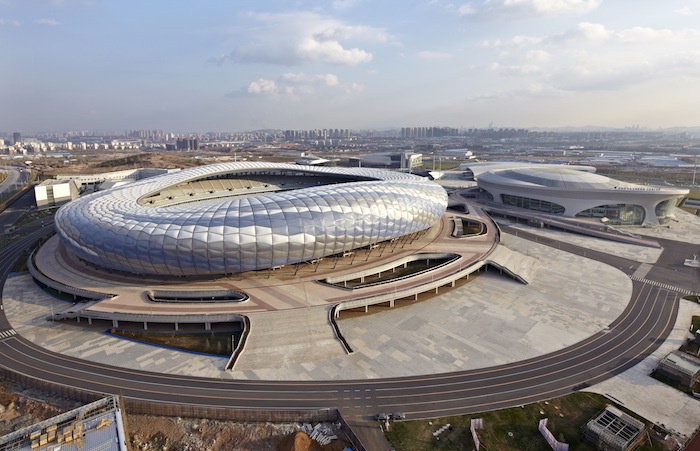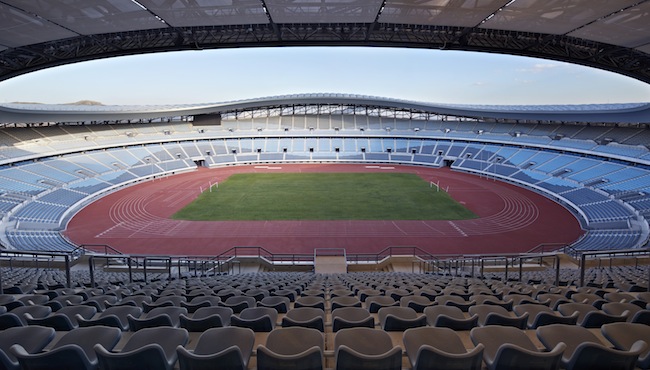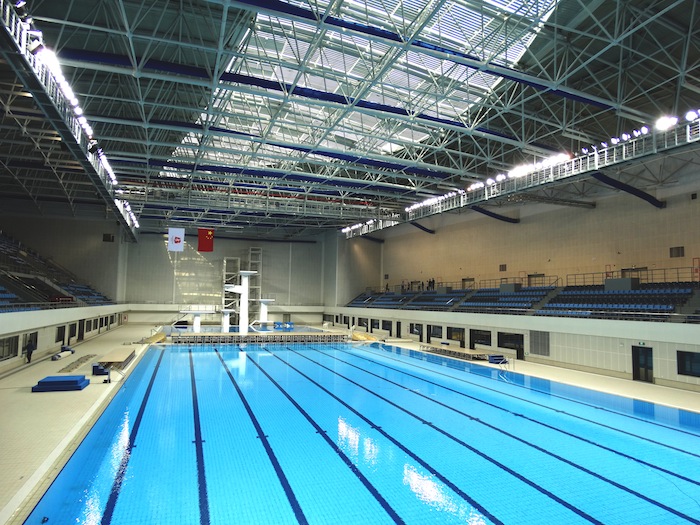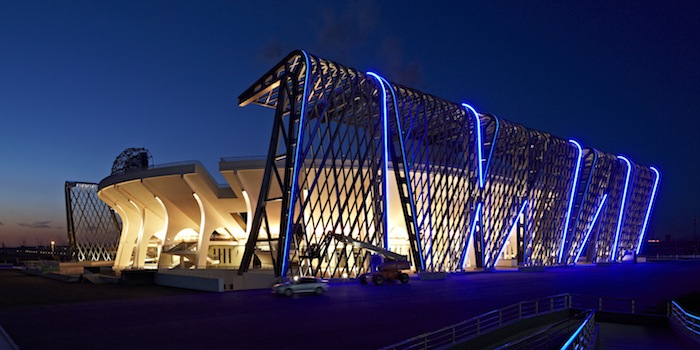Nadel Architects designed the new, world-class Dalian Sports Center, a massive 203-acre sports and entertainment complex located at 699 Lan Ling Rd., Ganjingzi District, Dalian, China on the Liaodong Peninsula adjacent to Korea.
The $1.5 billion project is the initial seed of urban development in the area. In addition to five major sports venues, the complex includes a 30-story, 440-room, 5-star Kempinski full-service hotel and conference center and a 40,500-square-meter athletes’ training facility and office building for coaches.
The sports complex, which hosted the China National Games upon completion of construction in September 2013, is designed to meet Olympic standards. The center is one of the only sports facilities in the world where all venues of this scale are incorporated on one site.
Venues include a 61,000-seat soccer stadium, an 18,000-seat indoor arena managed by AEG, a 9,600-seat tennis stadium, a 5,000-seat natatorium, a 3,000-seat baseball stadium, a comprehensive training and sports research facility as well as living quarters to accommodate athletes.

All photos: courtesy Nadel Architects
The city of Dalian prides itself as a “city of sports” with a specific reputation for being the “home of track and field,” “home of swimmers,” and the “city of soccer” in China.
Designed to accommodate numerous music concerts, sporting events, cultural and family events year-round, the new facility will not only serve as a regional sports center–propelling Dalian's world famous athletes to the forefront of training and international competition–but will also serve as an international tourist destination, entertainment venue and spiritually meaningful place to exercise, meditate and enjoy nature.
“In my 50-year career, this is the most remarkable project in which I’ve ever been involved,” said Herb Nadel, FAIA, founding principal of Nadel Architects. “I am terribly proud and excited to witness our team’s innovative design become a reality. Seeing this incredible center completed and built to world-class design standards is a true honor.”
Reinforcing the cohesiveness of the city's masterplan, the team, directed by Michael Hwa, planned the new year-round sports complex to connect residential neighborhoods with entertainment, retail and office space. The Dalian Sports Center creates a link through the heart of the city's newest development zone, becoming an anchor for the community and catapulting the city into a modern and connected city of the future.
Conceived as a “sports artery,” Dalian Sports Center incorporates an “S” shaped pathway as the main link between facilities during competition events. The pathway acts as a gently curving spine, crossing the site and connecting all the major venues like tendons connecting the muscles of the athletes.
Creatively blending landscape and the human form, the design effectively connects each of the sporting venues not only to each other, but also to the city's transportation infrastructure and to the community as a whole.
“The genesis behind the dynamic design of the facility was to capture the awe-inspiring speed, graceful lines and kinetic movements of competing athletes,” said Nadel. “Our design has connected the movement of the buildings with the muscles of the athletes – long graceful curves and lines – all providing a visual flow that captivates each person as they move through the complex.”
The main entrance to the sports center is a large, welcoming urban plaza that can accommodate up to 150,000 people. The cleverly landscaped plaza provides an immersive experience to the visitor through a necklace of intimately scaled spaces for relaxing, reading, meditation, tai chi, walking and enjoying music among seasonally changing gardens.
To conserve and reclaim water, these gardens have been ecologically engineered and terraced like traditional rice fields, flourishing year round with a variety of native plants and flowers.
The largest structure within the complex is the elliptical-shaped, 61,000-seat outdoor stadium, designed to accommodate soccer matches and other international sports competitions. Ethylene Tetrafluoroethylene (ETFE)–a transparent polymer popularized by Beijing’s Water Cube in the 2008 Summer Olympics–was used for the “skin” of the outdoor stadium due to its versatility.
The sophisticated material is lighter weight, transmits more light, insulates better and has a lower installation cost than glass or plastic. The stadium’s ETFE cushions, which are shades of white, grey and blue during the day, are illuminated with LED lights at night, displaying custom color patterns to represent the competing teams or to symbolize a particular event.
During winter, Dalian faces challenging weather and snow, requiring great ingenuity on the part of Nadel’s project team in the stadium’s design and materials used. To tackle this challenge, Nadel used Building Information Modeling (BIM) software to innovatively design, research and test the stadium exterior’s steel frame with a custom drainage system covered with a membrane of 2,745 ETFE cushions.
Adjacent to the outdoor stadium along the “S” pathway is the 18,000 seat indoor arena whose exterior features supple arching lines, representing an athlete’s muscles wrapping around a strong core. Managed by AEG, the indoor arena is used for an array of entertainment and sporting events including basketball, volleyball, table tennis, badminton, fencing, gymnastics, weight lifting, wrestling and martial arts, as well as a variety of music concerts.
The design of the natatorium was inspired by the waves of the sea. The natatorium boasts 5,000 spectator seats; a 10-lane, 50 meter pool for swimming, synchronized swimming and water polo competitions; a diving pool with 0.6, 2.6, 5.0, 7.5 and 10 meter diving platforms; an 8-lane, 50 meter warm up pool; and men’s and women’s locker rooms.
The 9,600-seat tennis stadium was designed to be both large and intimate, with every seat close to the action providing an unobstructed view of each event. The "seating bowl" of the arena sits within a live landscaped trellis structure, which embraces the spectators in field of green and light mirroring traditional European tennis venues and complementing the year-round landscaping of the “S” shaped pathway.
Nadel’s design team worked on a fast track schedule to complete the sports center in time for the 2013 China National Games. Nadel’s unique approach to the design and construction process allowed the entire project team to work together and develop an efficient timetable. The result is a facility that was completed under a tight deadline, without sacrificing the integrity of the design.
“This new facility is truly the architectural heart of the district, setting a benchmark for future developments that will serve the community,” said Nadel.
Joining Nadel on the project was Andrew Wolff, AIA, LEED® AP, senior designer; John Yang, project manager; and Michael Hwa, project director as well as a large team of designers and production staff.
Project Specifications
The 203-acre sports and entertainment complex features several areas for events and activities, including:
- 61,000-seat soccer stadium
- 18,000-seat indoor arena
- 9,600-seat tennis stadium
- 5,000-seat natatorium
- 3,000-seat baseball stadium
- 30-story, 440 room, 5-star Kempinski Hotel and media center
- 40,500-square-meter training and support research facility with 4 levels of athletic training space and 6 levels of office space for coaches
About Nadel Architects
For the past 40 years, Nadel Architects has provided comprehensive services ranging from architectural design, master planning and feasibility studies to complete interior design, planning and programming. Nadel is ranked among the largest architectural firms in the world (#60 per Building Design+Construction, Giant 300 list, 2012).
The company has completed more than 80,000 residential units, 30 million square feet of retail space, 600 office buildings, numerous hotels and resorts, and a variety of public and educational institutions, which have received more than 75 awards for design excellence. Headquartered in Los Angeles, the firm has designed a variety of projects located around the globe. For more information, please visit www.nadelarc.com.
Related Stories
High-rise Construction | Feb 23, 2024
Designing a new frontier in Seattle’s urban core
Graphite Design Group shares the design for Frontier, a 540,000-sf tower in a five-block master plan for Seattle-based tech leader Amazon.
Construction Costs | Feb 22, 2024
K-12 school construction costs for 2024
Data from Gordian breaks down the average cost per square foot for four different types of K-12 school buildings (elementary schools, junior high schools, high schools, and vocational schools) across 10 U.S. cities.
MFPRO+ Special Reports | Feb 22, 2024
Crystal Lagoons: A deep dive into real estate's most extreme guest amenity
These year-round, manmade, crystal clear blue lagoons offer a groundbreaking technology with immense potential to redefine the concept of water amenities. However, navigating regulatory challenges and ensuring long-term sustainability are crucial to success with Crystal Lagoons.
Architects | Feb 21, 2024
Architecture Billings Index remains in 'declining billings' state in January 2024
Architecture firm billings remained soft entering into 2024, with an AIA/Deltek Architecture Billings Index (ABI) score of 46.2 in January. Any score below 50.0 indicates decreasing business conditions.
University Buildings | Feb 21, 2024
University design to help meet the demand for health professionals
Virginia Commonwealth University is a Page client, and the Dean of the College of Health Professions took time to talk about a pressing healthcare industry need that schools—and architects—can help address.
AEC Tech | Feb 20, 2024
AI for construction: What kind of tool can artificial intelligence become for AEC teams?
Avoiding the hype and gathering good data are half the battle toward making artificial intelligence tools useful for performing design, operational, and jobsite tasks.
Engineers | Feb 20, 2024
An engineering firm traces its DEI journey
Top-to-bottom buy-in has been a key factor in SSOE Group’s efforts to become more diverse, equitable, and inclusive in its hiring, mentoring, and benefits.
Building Tech | Feb 20, 2024
Construction method featuring LEGO-like bricks wins global innovation award
A new construction method featuring LEGO-like bricks made from a renewable composite material took first place for building innovations at the 2024 JEC Composites Innovation Awards in Paris, France.
Codes and Standards | Feb 20, 2024
AISC, AIA release second part of design assist guidelines for the structural steel industry
The American Institute of Steel Construction and AIA Contract Documents have released the second part of a document intended to provide guidance for three common collaboration strategies.
Student Housing | Feb 19, 2024
UC Law San Francisco’s newest building provides student housing at below-market rental rates
Located in San Francisco’s Tenderloin and Civic Center neighborhoods, UC Law SF’s newest building helps address the city’s housing crisis by providing student housing at below-market rental rates. The $282 million, 365,000-sf facility at 198 McAllister Street enables students to live on campus while also helping to regenerate the neighborhood.






















